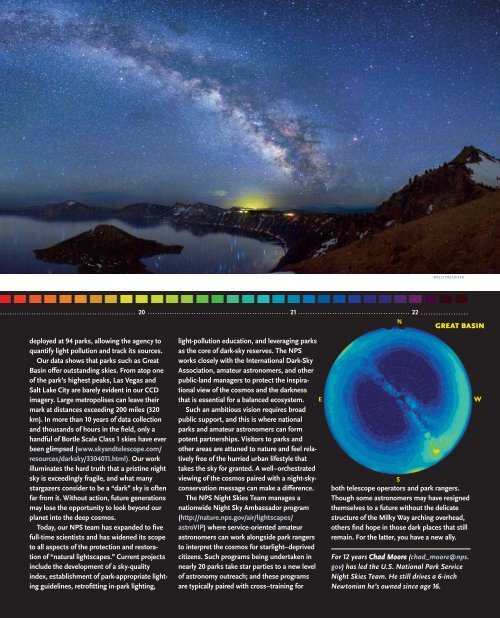Download this ebook as PDF - E-Book Library
Download this ebook as PDF - E-Book Library
Download this ebook as PDF - E-Book Library
You also want an ePaper? Increase the reach of your titles
YUMPU automatically turns print PDFs into web optimized ePapers that Google loves.
deployed at 94 parks, allowing the agency to<br />
quantify light pollution and track its sources.<br />
Our data shows that parks such <strong>as</strong> Great<br />
B<strong>as</strong>in off er outstanding skies. From atop one<br />
of the park’s highest peaks, L<strong>as</strong> Veg<strong>as</strong> and<br />
Salt Lake City are barely evident in our CCD<br />
imagery. Large metropolises can leave their<br />
mark at distances exceeding 200 miles (320<br />
km). In more than 10 years of data collection<br />
and thousands of hours in the fi eld, only a<br />
handful of Bortle Scale Cl<strong>as</strong>s 1 skies have ever<br />
been glimpsed (www.skyandtelescope.com/<br />
resources/darksky/3304011.html). Our work<br />
illuminates the hard truth that a pristine night<br />
sky is exceedingly fragile, and what many<br />
stargazers consider to be a “dark” sky is often<br />
far from it. Without action, future generations<br />
may lose the opportunity to look beyond our<br />
planet into the deep cosmos.<br />
Today, our NPS team h<strong>as</strong> expanded to fi ve<br />
full-time scientists and h<strong>as</strong> widened its scope<br />
to all <strong>as</strong>pects of the protection and restoration<br />
of “natural lightscapes.” Current projects<br />
include the development of a sky-quality<br />
index, establishment of park-appropriate lighting<br />
guidelines, retrofi tting in-park lighting,<br />
20 21 22<br />
N<br />
light-pollution education, and leveraging parks<br />
<strong>as</strong> the core of dark-sky reserves. The NPS<br />
works closely with the International Dark-Sky<br />
Association, amateur <strong>as</strong>tronomers, and other<br />
public-land managers to protect the inspirational<br />
view of the cosmos and the darkness<br />
that is essential for a balanced ecosystem.<br />
Such an ambitious vision requires broad<br />
public support, and <strong>this</strong> is where national<br />
parks and amateur <strong>as</strong>tronomers can form<br />
potent partnerships. Visitors to parks and<br />
other are<strong>as</strong> are attuned to nature and feel relatively<br />
free of the hurried urban lifestyle that<br />
takes the sky for granted. A well–orchestrated<br />
viewing of the cosmos paired with a night-skyconservation<br />
message can make a diff erence.<br />
The NPS Night Skies Team manages a<br />
nationwide Night Sky Amb<strong>as</strong>sador program<br />
(http://nature.nps.gov/air/lightscapes/<br />
<strong>as</strong>troVIP) where service-oriented amateur<br />
<strong>as</strong>tronomers can work alongside park rangers<br />
to interpret the cosmos for starlight–deprived<br />
citizens. Such programs being undertaken in<br />
nearly 20 parks take star parties to a new level<br />
of <strong>as</strong>tronomy outreach; and these programs<br />
are typically paired with cross–training for<br />
WALLY PACHOLKA<br />
GREAT BASIN<br />
E W<br />
S<br />
both telescope operators and park rangers.<br />
Though some <strong>as</strong>tronomers may have resigned<br />
themselves to a future without the delicate<br />
structure of the Milky Way arching overhead,<br />
others fi nd hope in those dark places that still<br />
remain. For the latter, you have a new ally.e<br />
For 12 years Chad Moore (chad_moore@nps.<br />
gov) h<strong>as</strong> led the U.S. National Park Service<br />
Night Skies Team. He still drives a 6-inch<br />
Newtonian he’s owned since age 16.<br />
SkyandTelescope.com May 2012 33


